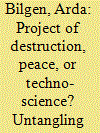|
|
|
Sort Order |
|
|
|
Items / Page
|
|
|
|
|
|
|
| Srl | Item |
| 1 |
ID:
191797


|
|
|
|
|
| Summary/Abstract |
Since the Syrian civil war broke out in 2011, the People’s Protection Units (Yekîneyên Parastina Gel, the YPG) has been one of the most notable groups in Syria. The group has become increasingly known especially after playing a significant role in the fight against the Islamic State in Iraq and Syria and, later on, declaring autonomy in northern Syria in 2014. While various political, economic, and social dimensions of the Rojava struggle and of the YPG have been examined within a wide array of fields, the group and its identity have not been adequately examined through a social-psychological lens thus far. In this study, we seek to fill this gap by examining how YPG supporters represent, understand, and express the identity and behaviour of their own group and their adversaries on social media, particularly on Twitter. In light of social identity theory, we explore YPG supporters’ (1) ingroup representations (both ingroup members and allies), (2) ingroup social norms, (3) outgroup representations, and (4) outgroup social norms. Thus, we not only present the first empirical study in this regard, but also discuss the meanings of identity content and social norms in relation to the processes of mobilization and solidarity among YPG supporters.
|
|
|
|
|
|
|
|
|
|
|
|
|
|
|
|
| 2 |
ID:
158064


|
|
|
|
|
| Summary/Abstract |
The Southeastern Anatolia Project (Güneydoğu Anadolu Projesi, GAP) was initiated in the 1970s to produce energy and irrigate arid lands through constructing dams and hydroelectric power plants on the Euphrates and Tigris rivers and extensive irrigation networks in southeastern Turkey. Over time, the project was expanded to achieve a wider range of goals in different fields and radically transform Southeastern Anatolia Region. It is also widely claimed that GAP was initiated to address the root causes of the Kurdish question in Turkey and that security considerations and political calculations were actually the raison d’être of GAP. However, this supposed link between GAP and the Kurdish question was often established in a simplistic manner and the question how these two have been related – or not – remained largely untangled. This article aims to fill this research gap and examine the complex and multi-dimensional nature of the interrelationship between GAP and the Kurdish question based on diverse primary and secondary data sources. Accordingly, the article identifies and discusses major narratives in which GAP was conceived as a political and strategic ‘anti-Kurdish’ plot; remedy for the conflict; and totally technical non-political project and presents an alternative and more accurate perspective on how to interpret this relationship.
|
|
|
|
|
|
|
|
|
|
|
|
|
|
|
|
| 3 |
ID:
175048


|
|
|
|
|
| Summary/Abstract |
The Southeastern Anatolia Project (Güneydoğu Anadolu Projesi, GAP) is one of the largest regional development projects ever implemented in the Middle East. Launched officially in the 1970s to develop the water and land resources of southeastern Turkey, GAP has over time evolved from a predominantly technical, largely state-led and mainly infrastructural and economic development-oriented project into a primarily social, largely market-friendly and chiefly sustainable and human development-oriented project. Parallel to this evolution, GAP has grown more visible in political and public discourses. The implications of the project, for instance, on the ecology and cultural heritages, on the Kurdish Question, and on water issue among Turkey, Syria and Iraq have become clearer. However, despite growing academic and policy interest on GAP, there has been no attempt to provide a literature review on the project. Even more than 40 years after GAP was begun, a bird’s eye view of researched and under-researched topics in the literature has not been introduced yet. This article seeks to present a qualitative review of GAP-related literature. In this way, it seeks to constitute an initial step to establish a base for more expansive reviews and to provide guidance to interested and involved researchers, practitioners and policymakers.
|
|
|
|
|
|
|
|
|
|
|
|
|
|
|
|
|
|
|
|
|